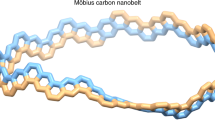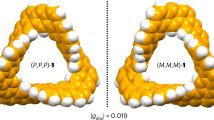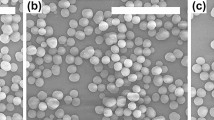Abstract
The structure-selective precise synthesis of carbon nanotubes (CNTs) has been long sought in materials science. The aromatic molecules corresponding to segment structures of CNTs, that is, carbon nanobelts (CNBs), are of interest as templates for CNT growth. Among the three types of CNB (armchair, chiral and zigzag CNBs), zigzag CNBs have been considered the most difficult type to synthesize. Here we report the synthesis, isolation and structural characterization of a zigzag CNB. The synthesis involves an iterative Diels–Alder reaction sequence followed by reductive aromatization of oxygen-bridged moieties. As predicted by theoretical calculations, this CNB was isolated as a stable compound. The structure of the zigzag CNB was fully characterized by X-ray crystallography and its wide energy gap with blue fluorescence properties was revealed by photophysical measurements. With synthetic strategies towards all three types of CNB in hand, the road to the precise synthesis of CNTs can now proceed to the next stage.

This is a preview of subscription content, access via your institution
Access options
Access Nature and 54 other Nature Portfolio journals
Get Nature+, our best-value online-access subscription
$29.99 / 30 days
cancel any time
Subscribe to this journal
Receive 12 print issues and online access
$259.00 per year
only $21.58 per issue
Buy this article
- Purchase on Springer Link
- Instant access to full article PDF
Prices may be subject to local taxes which are calculated during checkout




Similar content being viewed by others
Data availability
Materials and methods, experimental procedures, photophysical studies and NMR spectra are available in the Supplementary Information. Crystallographic data for the structures reported in this Article have been deposited at the Cambridge Crystallographic Data Centre, under deposition number CCDC 1992947 (1). Copies of the data can be obtained free of charge via https://www.ccdc.cam.ac.uk/structures/. Source data are provided with this paper.
References
Kawase, T. & Kurata, H. Ball-, bowl-, and belt-shaped conjugated systems and their complexing abilities: exploration of the concave–convex π–π interaction. Chem. Rev. 106, 5250–5273 (2006).
Tahara, K. & Tobe, Y. Molecular loops and belts. Chem. Rev. 106, 5274–5290 (2006).
Eisenberg, D., Shenhar, R. & Rabinovitz, M. Synthetic approaches to aromatic belts: building up strain in macrocyclic polyarenes. Chem. Soc. Rev. 39, 2879–2890 (2010).
Petrukhina, M. A. & Scott, L. T. (eds) Fragments of Fullerenes and Carbon Nanotubes: Designed Synthesis, Unusual Reactions, and Coordination Chemistry (Wiley, 2012).
Segawa, Y., Yagi, A., Matsui, K. & Itami, K. Design and synthesis of carbon nanotube segments. Angew. Chem. Int. Ed. 55, 5136–5158 (2016).
Segawa, Y., Ito, H. & Itami, K. Structurally uniform and atomically precise carbon nanostructures. Nat. Rev. Mater. 1, 15002 (2016).
Schröder, A., Mekelburger, H.-B. & Vögtle, F. in Cyclophanes (ed. Weber, E.) 179–201 (Springer, 1994).
Gleiter, R., Esser, B. & Kornmayer, S. C. Cyclacenes: hoop-shaped systems composed of conjugated rings. Acc. Chem. Res. 42, 1108–1116 (2009).
Evans, P. J. & Jasti, R. in Polyarenes I (eds Siegel, J. S. & Wu, Y.-T.) 249–290 (Springer, 2014).
Segawa, Y., Yagi, A., Ito, H. & Itami, K. A theoretical study on the strain energy of carbon nanobelts. Org. Lett. 18, 1430–1433 (2016).
Iijima, S. Helical microtubules of graphitic carbon. Nature 354, 56–58 (1991).
Omachi, H., Nakayama, T., Takahashi, E., Segawa, Y. & Itami, K. Initiation of carbon nanotube growth by well-defined carbon nanorings. Nat. Chem. 5, 572–576 (2013).
Sanchez-Valencia, J. R. et al. Controlled synthesis of single-chirality carbon nanotubes. Nature 512, 61–64 (2014).
Povie, G., Segawa, Y., Nishihara, T., Miyauchi, Y. & Itami, K. Synthesis of a carbon nanobelt. Science 356, 172–175 (2017).
Povie, G., Segawa, Y., Nishihara, T., Miyauchi, Y. & Itami, K. Synthesis and size-dependent properties of [12], [16], and [24]carbon nanobelts. J. Am. Chem. Soc. 140, 10054–10059 (2018).
Cheung, K. Y. et al. Synthesis of armchair and chiral carbon nanobelts. Chem 5, 838–847 (2019).
Heilbronner, E. Molecular orbitals in homologen reihen mehrkerniger aromatischer kohlenwasserstoffe: I. Die eigenwerte von LCAO‐MO’s in homologen reihen. Helv. Chim. Acta 37, 921–935 (1954).
Clar, E. The Aromatic Sextet (Wiley, 1972).
Chen, Z. et al. Open-shell singlet character of cyclacenes and short zigzag nanotubes. Org. Lett. 9, 5449–5452 (2007).
Kohnke, F. H., Slawin, A. M. Z., Stoddart, J. F. & Williams, D. J. Molecular belts and collars in the making: a hexaepoxyoctacosahydro[12]cyclacene derivative. Angew. Chem. Int. Ed. Engl. 26, 892–894 (1987).
Ashton, P. R. et al. Molecular lego 1. Substrate-directed synthesis via stereoregular Diels–Alder oligomerizations. J. Am. Chem. Soc. 114, 6330–6353 (1992).
Cory, R. M., McPhail, C. L., Dikmans, A. J. & Vittal, J. J. Macrocyclic cyclophane belts via double Diels-Alder cycloadditions: macroannulation of bisdienes by bisdienophiles. synthesis of a key precursor to an [8]cyclacene. Tetrahedron Lett. 37, 1983–1986 (1996).
Kintzel, O., Luger, P., Weber, M. & Schlüter, A.-D. Ring-chain equilibrium between an [18]cyclacene derivative and a ladder oligomer. Eur. J. Org. Chem. 1998, 99–105 (1998).
Schulz, F. et al. Exploring a route to cyclic acenes by on-surface synthesis. Angew. Chem. Int. Ed. 58, 9038–9042 (2019).
Shi, T.-H., Guo, Q.-H., Tong, S. & Wang, M.-X. Toward the synthesis of a highly strained hydrocarbon belt. J. Am. Chem. Soc. 142, 4576–4580 (2020).
Matsui, K., Fushimi, M., Segawa, Y. & Itami, K. Synthesis, structure, and reactivity of a cylinder-shaped cyclo[12]orthophenylene[6]ethynylene: toward the synthesis of zigzag carbon nanobelts. Org. Lett. 18, 5352–5355 (2016).
Wang, J. & Miao, Q. A tetraazapentacene–pyrene belt: toward synthesis of N-doped zigzag carbon nanobelts. Org. Lett. 21, 10120–10124 (2019).
Chen, H., Gui, S., Zhang, Y., Liu, Z. & Miao, Q. Synthesis of a hydrogenated zigzag carbon nanobelt. CCS Chem. 2, 613–619 (2020).
Esser, B., Rominger, F. & Gleiter, R. Synthesis of [6.8]3cyclacene: conjugated belt and model for an unusual type of carbon nanotube. J. Am. Chem. Soc. 130, 6716–6717 (2008).
Narita, A. et al. Synthesis of structurally well-defined and liquid-phase-processable graphene nanoribbons. Nat. Chem. 6, 126–132 (2014).
Geuenich, D., Hess, K., Köhler, F. & Herges, R. Anisotropy of the induced current density (ACID), a general method to quantify and visualize electronic delocalization. Chem. Rev. 105, 3758–3772 (2005).
Schleyer, Pv. R., Maerker, C., Dransfeld, A., Jiao, H. & Hommes, N. J. R. v. E. Nucleus-independent chemical shifts: a simple and efficient aromaticity probe. J. Am. Chem. Soc. 118, 6317–6318 (1996).
Colwell, C. E., Price, T. W., Stauch, T. & Jasti, R. Strain visualization for strained macrocycles. Chem. Sci. 11, 3923–3930 (2020).
Jasti, R., Bhattacharjee, J., Neaton, J. B. & Bertozzi, C. R. Synthesis, characterization, and theory of [9]-, [12]-, and [18]cycloparaphenylene: carbon nanohoop structures. J. Am. Chem. Soc. 130, 17646–17647 (2008).
Takaba, H., Omachi, H., Yamamoto, Y., Bouffard, J. & Itami, K. Selective synthesis of [12]cycloparaphenylene. Angew. Chem. Int. Ed. 48, 6112–6116 (2009).
Neudorff, W. D., Lentz, D., Anibarro, M. & Schlüter, A. D. The carbon skeleton of the belt region of fullerene C84 (D2). Chem. Eur. J. 9, 2745–2757 (2003).
Denekamp, C. et al. Towards a fully conjugated, double-stranded cycle: a mass spectrometric and theoretical study. Chem. Eur. J. 14, 1628–1637 (2008).
Standera, M. et al. Evidence for fully conjugated double-stranded cycles. Chem. Eur. J. 17, 12163–12174 (2011).
Franz, D., Robbins, S. J., Boeré, R. T. & Dibble, P. W. Synthesis and characterization of 2,7-di(tert-butyl)pyreno[4,5-c:9,10-c′]difuran and derived pyrenophanes. J. Org. Chem. 74, 7544–7547 (2009).
Murai, M., Ogita, T. & Takai, K. Regioselective arene homologation through rhenium-catalyzed deoxygenative aromatization of 7-oxabicyclo[2.2.1]hepta-2,5-dienes. Chem. Commun. 55, 2332–2335 (2019).
Bühner, M. et al. A novel type of cationic host molecules with π-acceptor properties. Angew. Chem. Int. Ed. Engl. 27, 1553–1556 (1988).
Xu, Y. et al. Highly strained, radially π-conjugated porphyrinylene nanohoops. J. Am. Chem. Soc. 141, 18500–18507 (2019).
Han, Y., Dong, S., Shao, J., Fan, W. & Chi, C. Synthesis of a sidewall fragment of a (12,0) carbon nanotube. Angew. Chem. Int. Ed. https://doi.org/10.1002/anie.202012651 (2020).
Acknowledgements
This work was supported by JST ERATO grant number JPMJER1302 (K.I.), JSPS KAKENHI grant numbers 19H05463 (K.I.), JP16K05771 (Y.S.), JP19H02701 (Y.S.), JP19K22183 (Y.S.) and the Murata Science Foundation (Y.S.). K.Y.C. acknowledges the Croucher Foundation Fellowship programme. K.W. acknowledges the Special Inter-University Researcher programme of the Institute for Molecular Science. We thank R. Okude and H. Shudo for assistance with the measurements, V. Gandikota, K. Matsui and K. Okada for pioneering synthetic attempts and I. A. Stepek for fruitful comments. Mass spectrometry was supported by the Toray Research Center. Calculations were performed using the resources of the Research Center for Computational Science, Okazaki, Japan. The Institute of Transformative Bio-Molecules (ITbM) is supported by the World Premier International Research Center Initiative (WPI), Japan.
Author information
Authors and Affiliations
Contributions
K.I., Y.S. and K.Y.C. conceived the concept and directed the project. Y.S. performed the X-ray crystallography. K.Y.C. performed the experiments. K.Y.C. and K.W. performed the computational studies. All authors contributed to preparing the manuscript.
Corresponding authors
Ethics declarations
Competing interests
The authors declare no competing interests.
Additional information
Peer review information Nature Chemistry thanks Birgit Esser, Ramesh Jasti and the other, anonymous, reviewer(s) for their contribution to the peer review of this work.
Publisher’s note Springer Nature remains neutral with regard to jurisdictional claims in published maps and institutional affiliations.
Supplementary information
Supplementary Information
Supplementary Figs. 1–26, discussion and Tables 1 and 2.
Supplementary Data 1
Cartesian coordinates (XYZ files) of optimized structures.
Supplementary Data 2
Source data in Microsoft Excel format for Supplementary Figs. 4 and 10a,b.
Supplementary Data 3
Raw NMR data.
Supplementary Data 4
Crystallographic data for compound 1. CCDC reference 1956026.
Source data
Source Data Fig. 4.
Source Data for Fig. 4a.
Rights and permissions
About this article
Cite this article
Cheung, K.Y., Watanabe, K., Segawa, Y. et al. Synthesis of a zigzag carbon nanobelt. Nat. Chem. 13, 255–259 (2021). https://doi.org/10.1038/s41557-020-00627-5
Received:
Accepted:
Published:
Issue Date:
DOI: https://doi.org/10.1038/s41557-020-00627-5
This article is cited by
-
The reformation of catalyst: From a trial-and-error synthesis to rational design
Nano Research (2024)
-
Rupturing aromaticity by periphery overcrowding
Nature Chemistry (2023)
-
Active template strategy for the preparation of π-conjugated interlocked nanocarbons
Nature Chemistry (2023)
-
How constraint programming can help chemists to generate Benzenoid structures and assess the local Aromaticity of Benzenoids
Constraints (2022)
-
Buckling up zigzag nanobelts
Nature Chemistry (2021)



